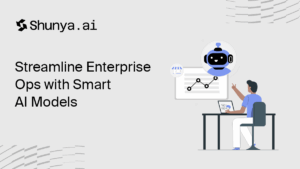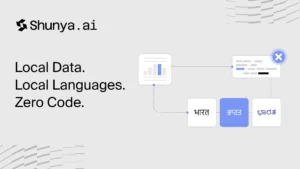Blog Summary
|
India is home to over 121 languages and 22 scheduled languages, spoken across 6,000+ dialects. Its digital users—especially from Tier 2 and Tier 3 regions—communicate not just in one language but in hybridised forms like Hinglish, Tamlish, or Kannada-English.
To unlock the next wave of digital inclusion, enterprises must move beyond English-first systems and adopt Multilingual AI chatbots in India that are accurate, context-aware, and culturally aligned.
Large Language Models (LLMs) trained on Indian languages are no longer optional—they are essential for enabling commerce, governance, healthcare, and customer service in the real Bharat.
Why Multilingual AI Matters in India
The Language Divide in Digital Services
Most chatbots and AI assistants today struggle with:
- Regional language understanding
- Code-mixed inputs (e.g. “Mujhe account balance dekhna hai”)
- Low-resource languages like Maithili or Tulu
- Dialectal diversity within the same language (e.g. Marathi in Pune vs Nagpur)
The result? Misunderstood queries, frustrated users, and digital drop-offs.
Impact on Enterprise Outcomes
- eCommerce: Product discovery fails when users type in local phrases
- Fintech: Tier 3 users prefer vernacular onboarding flows
- Logistics: Address parsing breaks down with code-mixed inputs
- Healthcare: Patients describe symptoms in native expressions
By deploying Multilingual AI chatbots in India, enterprises can improve accessibility, engagement, and retention across Bharat.
Key Pillars of Multilingual LLM Development
1. Dataset Diversity and Regional Representations
Training a multilingual model starts with the right data.
Data Sources:
- Regional newspapers, social media, OTT subtitles
- Government forms and translated corpora (e.g. PMGDISHA, ECI data)
- Open datasets like AI4Bharat, Bhāṣā, and Samanantar
- Crowdsourced conversational data from rural users
Considerations:
- Include code-mixed and transliterated scripts
- Capture urban and rural dialectal variations
- Annotate spelling errors common in Roman-script usage
2. Tokenisation for Indian Languages
Unlike English, Indian scripts are morphologically rich. Tokenising “कामकाज” or “కుమారుడు” is significantly more complex than “work”.
Strategies:
- SentencePiece or Byte-Pair Encoding with script-aware preprocessing
- Subword units to handle inflections and compound words
- Joint tokenisers across Devanagari, Latin, Tamil, Kannada scripts
💡 Note: Transliteration-based tokenisers allow models to handle “Hinglish” or “Tamlish” better without translation.
3. Transfer Learning and Few-Shot Techniques
Low-resource languages like Bodo or Manipuri lack sufficient text data.
Solutions:
- Transfer learning from high-resource Indian languages (e.g. Hindi)
- Use few-shot and zero-shot capabilities from multilingual LLMs
- Employ adapters (like LoRA) for lightweight regional tuning
This helps models learn the structure of lesser-known languages by drawing similarities from linguistically related ones.
4. Evaluation Beyond BLEU Scores
Generic metrics like BLEU or ROUGE are insufficient in multilingual settings.
Improved Metrics:
- Bhāṣā Score: Indian-language specific quality benchmark
- Human evaluations: Native speaker ratings for fluency and cultural appropriateness
- Intent match: Accuracy in chatbot goal completion in each language
Challenges in Scaling Multilingual Chatbots for Bharat
| Challenge | Impact | Mitigation Strategy |
|---|---|---|
| Lack of annotated corpora | Lower accuracy in niche dialects | Use translation pairs, data augmentation |
| Code-mixed query ambiguity | Incorrect intent classification | Train on noisy, real-world messages |
| Spelling variation in translit. | Token mismatch and model errors | Normalise phonetic inputs |
| UI/UX inconsistencies | User drop-off in regional flows | Dynamic language detection and font fallback |
How Shunya AI Solves This for Enterprises
Shunya AI is purpose-built for Bharat’s linguistic landscape. It enables the deployment of Multilingual AI chatbots in India that go far beyond traditional translation-based approaches.
Key Capabilities
- Real-time code-mix understanding across Hindi-English, Tamil-English, and more
- Multimodal inputs including voice, text, and image understanding in regional languages
- Pre-trained Indian LLMs fine-tuned on diverse public and private corpora
- Custom chatbot deployment tools for WhatsApp, IVR, and mobile apps
Shunya AI’s architecture is designed for Indian enterprises that want to scale their services across states and scripts—with compliance, security, and adaptability.
Real-World Applications Across Sectors
Banking and Fintech
- Vernacular onboarding bots
- Regional KYC assistance
- Voice-based balance checks
eCommerce and Logistics
- Product search via regional queries
- Address validation in local languages
- Support bots that handle Hindi-English-Telugu inputs
Government and Public Services
- Citizen helplines with multilingual options
- IVR bots that speak and understand rural dialects
- Multilingual grievance redressal tools
Inclusive AI for Bharat
At the core of Shunya lies the belief that AI must mirror the voice of Bharat—not just its cities but its heartlands.
By focusing on linguistic plurality, multimodal access, and regional sensitivity, Shunya ensures that every Indian—irrespective of language or literacy level—can access AI-driven services confidently and meaningfully.
This is AI made not just in India, but for India.
Whether you’re serving customers in Surat or Shivamogga, Shunya AI equips you with the tools to build scalable, intelligent, and inclusive chatbots.
Shunya AI supports all major Indian languages including Hindi, Tamil, Telugu, Kannada, Bengali, Marathi, Gujarati, and Hinglish, with ongoing expansion into dialectal variations.
Yes. Shunya’s models are trained on real-world code-mixed data and can handle transliteration, Hinglish queries, and hybrid utterances with high accuracy.
Not always. Shunya offers pre-trained models that cover most regional intents. However, for domain-specific applications (e.g. local banking terms), light fine-tuning or adapter-based tuning is recommended.
Absolutely. Shunya provides plug-and-play deployment for WhatsApp, IVR, mobile apps, and web interfaces—with multilingual flows fully supported.



